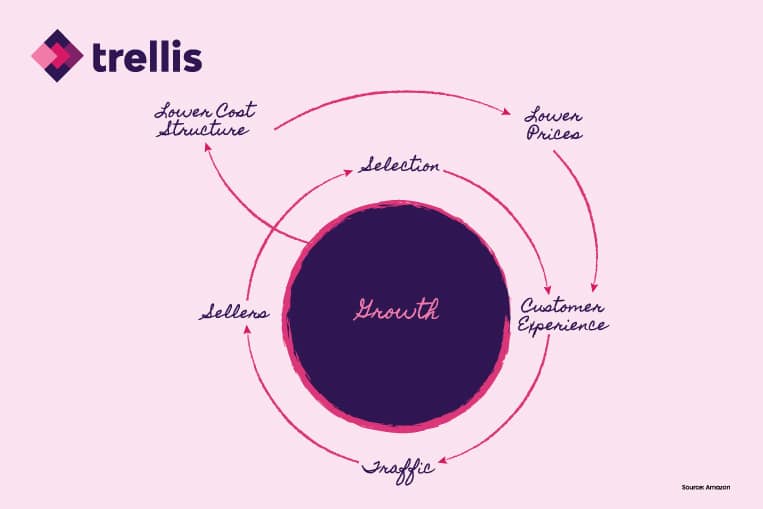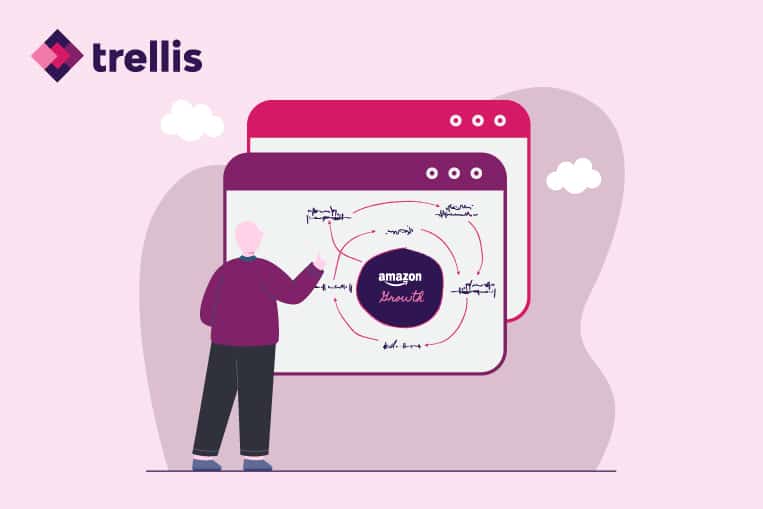Amazon is undoubtedly the hottest marketplace in eCommerce. Even after the pandemic-troubled year, 2021 saw a giant posting of $33.36 Billion in net income, a whopping 56% jump.
So what gives? How is Amazon unwavering even after one of the biggest pandemics? What is their business model?
Well, we could date it back to 2001, when Amazon founder, Jeff Bezos, sketched out the Amazon Flywheel Model. The sketch evolves around quality products, lower prices, and great customer service.
In this blog, we will talk about what is the Amazon Flywheel, how the model works, what Amazon sellers can learn, and how Amazon sellers can create their own flywheel for business growth.
What is Amazon Flywheel?
The Amazon Flywheel concept is not a linear business framework, but a continuous cycle that runs in loops. One strategy of the business reinforces or helps the other to move forward.
The model is inspired by the continued momentum that you get from an actual flywheel. So every paddle helps you retain energy and helps you move forward in the next one.
Let’s look at the Amazon Flywheel.

With great product selection, low prices, and great customer service, the customer tends to come back. As such, you don’t need to put in the same effort for the next paddle. Your product, price, and customer service, bring more customers back.
And if you keep that for long enough, you move fast, and grow faster.
Let’s dive deeper into what makes this model a flywheel.
So, how does the Amazon Flywheel Model work?
In the world of transparent online reviews, customer satisfaction has become the epitome of business success. While business growth is at the core of the above Amazon flywheel diagram, a focus on customer satisfaction fuels the momentum i.e the flywheel effect.
We can see a couple of merging cycles in the Amazon Flywheel.
Here is how the first one works:
- Sellers: Third-party sellers on the platform spark competition and increase choices.
- Selection: More sellers bring diverse product selection and competition leads to lower prices.
- Customer Service: The positive customer experience and lower prices lead to repeated purchases.
- Traffic: Increased traffic from repeated customers attracts third-party sellers, boosting growth.
More sellers mean a wider selection, and the cycle repeats itself. This model works perfectly for any marketplace if the infrastructure is in place.
The second cycle adds the flywheel effect and moves the wheel faster with less effort:
- Lower cost structure: Business growth facilitates lower-cost structure.
- Lower prices: Low-cost setup enables lower pricing capacity for sellers.
- Customer Satisfaction: Low prices further leave the customer satisfied.
This cycle goes into self-sustaining momentum getting faster fueling business growth.
But the question is, if you are not a marketplace and only a third-party seller on Amazon, how can you take advantage of this business model?
How a seller can build upon Amazon’s Flywheel model to supercharge success
Understanding Amazon Flywheel helps you create a design that focuses on your success. Remember, the goal is growth. So focus on the following:
Boosts sales → gain reviews → increase rankings → skyrocket sales
1. Boosting Sales
The first step is to focus on increased sales making sure your product is presented in the best way. For Amazon product listings, you need a fully optimized product listing with A+ Content. Great content helps if your product has no or fewer reviews. Here is what you can do make your product listing content great.
However, to boost sales despite an optimized listing, promoting your product through ads and discounts can prove to be a catalyst in boosting your sales.
2. Getting More Reviews
More sales catapults your chances of getting more reviews from customers. Remember to encourage buyers to leave a review after a few days of purchasing and using your product.
More reviews can boost your sales and increase your visibility or ranking i.e the Best Seller Rank (BSR).
Here are some of the top techniques to get more reviews on Amazon.
3. Increasing Ranking
More positive reviews get you more sales and eventually, a better BSR. A higher rank will bring in more organic traffic, hence, creating a flywheel effect.
However, Amazon is getting more competitive as there are other products and brands looking for better rankings. Therefore, the effort to get the flywheel going may also require something more, i.e. competitive pricing.
Lower pricing can get you the buy box if you are a reseller. Competitive pricing can make you stand out among other private-label sellers, hence, moving the wheel faster.
Pricing is just one tactic sellers can use to create their own flywheel strategy as products and categories differ, and may require different strategies.
How to start your own Amazon Flywheel strategy
The Flywheel model isn’t another road map—it’s a mindset you incorporate into your brand to accelerate your growth and hit those KPIs. Here are some of the actions that can boost your brand and business:
1. Offer amazing products
Poor products are a recipe for a plummeting brand. Not even your best advertising and customer experience efforts can save them.
So create a product that customers will rush to grab:
- Cherry-pick an interesting niche you understand inside-out
- Research the products that can bring an avalanche of sales, considering the competition and keyword search volume
- Tailor the items to be unique to stand above the pack
- Negotiate with your supplier to cut the initial price or MOQ, allowing you to attract more customers in the future by reducing the price
Ask the supplier to send you samples of goods they’ve manufactured. You don’t want to end up with a container full of substandard, fake, or faulty items.
2. Improve customer experience
Customer interaction with your brand should leave them smiling and desiring to return for more. So how do you know what’s working and what isn’t? Closely monitor relevant performance indicators on online platforms. Such KPIs include:
- Net Promoter Score (NPS)
- Average resolution time
- Ticket volume
- Average response time
Adopt new approaches proactively to improve customer experience. Buyers should have a smooth journey from discovering your product to the post-purchase stage. Ensure they enjoy the following:
- The best prices
- Wide product selection
- Professional customer service
- Excellent delivery
3. Be creative
Amazon is famous for rolling out dynamic and innovative approaches—from same-day shipping to Amazon Prime to Prime Video. You can borrow a leaf from this giant to make your brand roar.
Try different messaging to see if other audiences also want to use your product. Create a buzz using social media. Share common values with your audience. Share as much info as you can about the product.
Have you discovered a well-kept advertising secret? How can you tailor deals that turn eyeballs into clicks and sales? Avoid stale strategies and explore new ways of jumpstarting your flywheel game. Build on the momentum with even more innovative strategies.
4. Encourage more visitors to your listing
Let Amazon and non-Amazon customers know about your product. Here are some of the tactics to employ:
- Befriend smart PPC ads with automation
- Gather as many reviews as possible to start gaining traction
- Roll out prizes, discounts, and coupons in the first few weeks after the launch
Position yourself through enticing blogs, videos, webinars, and other top-quality pieces that your readers love. This long-term strategy will eventually draw non-Amazon customers to your brand.
5. Work on SEO
Search Engine Optimization (SEO) is a perfect flywheel tactic. Strong SEO opens you up to more organic opportunities which can snowball into thousands of daily users.
Therefore, optimize your listings to rank high on Amazon and other marketplaces’ search engine results pages (SERP). Inject targeted keywords into various areas, such as your merchandise name, description, and feature lists.
Play your cards well, and you’ll gain high SERP visibility, leaving your competitors in the dust. The best part? You get more sales and better rankings.
6. Monitor your merchandise
Your items form an integral part of the Flywheel. So review your catalog and inventory periodically, taking note of the following:
- Best-selling products
- Underperforming items
- Items that are no longer in demand
Replenishing dwindling stock isn’t enough. Instead, always keep an eye on new methods to widen product selection. Don’t retire a product unless it has proved unsellable. To learn what most you get out of your old inventory, learn more about Dynamic Pricing.
7. Prioritize your reputation
Reputation is everything if you look to slice through the online noise. Most customers will check out reviews about your products before fishing out their credit cards.
So cement a rock-solid reputation through having:
- Reliable website
- Positive reviews
- Established customer base
- Social media platforms with engaged fans
These and other trust signals separate the greatest from the good brands.
Also, the stages of your customer journey are closely interlinked. So always track, manage, and increase your reputation.
Trellis and the Amazon Flywheel Effect
There is more to leveraging the flywheel effect, through Trellis and its smarter eCommerce solutions.
To boost sales, advertising can be one of the most effective ways to get traffic. As our advertising automation helps find converting keywords and opportunities, we can accelerate bids for a competitive advantage. You can run quick tests and move the wheel faster.
To add the flywheel effect, dynamic pricing can help you get the most optimal prices based on your goal of either sales or profit. If you automate the prices on your products that your customers are willing to pay while maintaining profitability, it can boost your sales, keep you profitable, and provide customer satisfaction to get the flywheel effect.
You can also track the flywheel effect through our market intelligence metrics including increase in Customer Value(CV), Brand Value(BV), New-to-Brand (NTB), Share of Voice (SoV), Share of Shelf (SoS), and more.
Talk to our experts to learn more about how automation and pricing tools can help you grow faster.



